(Conservatively managed fragility fracture of the humerus).
This information is for people who most likely won’t need an operation after breaking their arm. This means you don’t need to come back to the hospital to see the orthopaedic doctors or have another X-ray in the Fracture Clinic routinely.
Please see the phone numbers at the end of the page if you have any questions or concerns following your injury.
These guidelines work for most people in your situation who have had a similar injury. It will help your recovery if you follow them as best you can. The information can also be used by the people involved in your care for those that are unable to follow the advice on the page themselves.
Summary:
- Ask someone to help during your recovery.
- Wear loose clothing.
- Take regular pain killers as advised by your doctor.
- Stay well hydrated and take laxatives if needed.
- Use a simple sling (collar and cuff) to help ease the pain when you are moving.
- Wash your injured arm every day, then ensure it’s properly dry.
- Allow your arm to hang straight at least twice a day.
- Remove rings or jewellery on your injured limb as soon as possible after the injury and keep them off until the swelling has gone down fully.
Practical considerations:
- You should write down the date you have broken you upper arm/shoulder.
- It’s unlikely you will be able to use your arm properly while it is healing so you will need extra help during this time. This could be from family, friends or you may need extra help from the community support team.
- Please do not put pillows or support under your elbow or behind your upper arm. This can increase pain by pushing on the broken bone. You can however rest your hand on a pillow to elevate it which may help a little with the swelling.
- Consider loose clothing for comfort, ease of dressing, and getting to the toilet. A loose shirt for your top half and trousers or skirts with elasticated waists can make a big difference on how you cope at home. Put your injured arm in the sleeve first (and remove last) to reduce pain and unnecessary movement.
Giving your neck a rest from the sling
This is a good position to give your neck a rest from the sling.
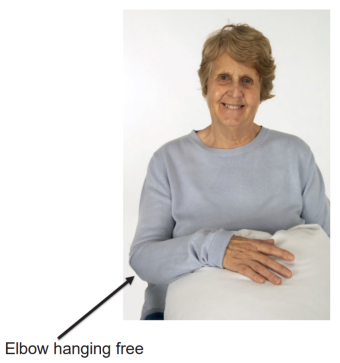
Looking after your skin
It’s important that you don’t allow sores to develop under your arm, so you or your carer need to:
- Wash your injured arm carefully every day and make sure your under arm is really dry.
- Do not wear rings or jewellery for 6 weeks to reduce the risk of complications from swelling.
- Massage your hand and arm regularly with any moisturiser. This may help a little with swelling and it can also reduce any fear you may have about touching your arm.
Preventing chest infections
There is an increased risk of developing a chest infection while you are recovering. You are likely to be less mobile than normal and you may also find your arm hurts when you breathe deeply.
Taking deep breaths can reduce the risk of chest infections by keeping your lower airway working well and by reducing the build-up of secretions. To help reduce this risk:
- Breathe in slowly through your nose; imagine the base of your lungs expanding fully.
- Slowly exhale through your mouth.
- Do this 2 to 3 times in a row.
- Try to do this every half hour if you can. You could set a timer, ask a family member or carer to remind you, or if you are watching television, use the adverts as a prompt.
What to expect in your recovery
0-3 weeks
Pain and swelling
- The injured arm is likely to be very painful at first. It’s important that you keep the pain under control as much as possible. Please ensure you take regular painkillers as recommended by your doctor.
- It can be difficult to manage your medication with one hand. Practice and tell someone as soon as possible if you cannot manage. Community teams (for example hospital discharge teams and district nurses) cannot usually help with medications so you might need a plan for this before you leave hospital.
- It is quite common with this type of injury for the pain to increase in the first 1-2 weeks. This is due to swelling and inflammation as much as the injury itself.
- It is possible your whole arm may swell and bruise including your hand and fingers. It can help to know what is normal and that it will get better in time. But if you are worried or have new numbness please speak to a health professional.
- Constipation is a common side effect of painkillers and reduced activity. Please try to stay well hydrated and take laxatives if required. It is important to seek advice from a health professional if you remain constipated.
- A simple collar and cuff (see picture on front page) will help to support your arm and reduce the pain when you are moving. If you are having any issues with your sling please contact the Plaster Room on 0117 414 8606.
Exercises
To prevent the joints from becoming stiff you should:
Allow your injured arm to hang straight at the elbow at least twice a day – more often if possible.
Standing with your arm hanging as pictured can be a good position to clean under your arm and to put your arm into clothing when dressing.
If you are not safe to stand, try to hang your arm straight from a seated position if you can safely and carefully do so. You may need help from a family member or carer to do this.
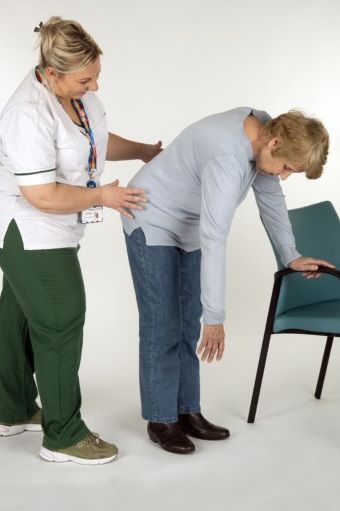
Keep your fingers and wrist moving – make a tight fist and open your hand fully throughout the day.
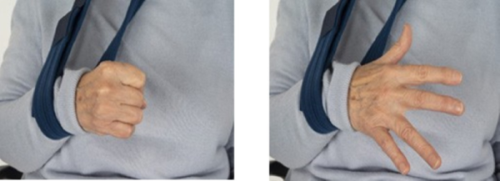
Once your pain has settled a bit it’s time to get your elbow moving. Remove your sling and gently extend your arm. Now bend your elbow and try to bring your hand up towards your shoulder.
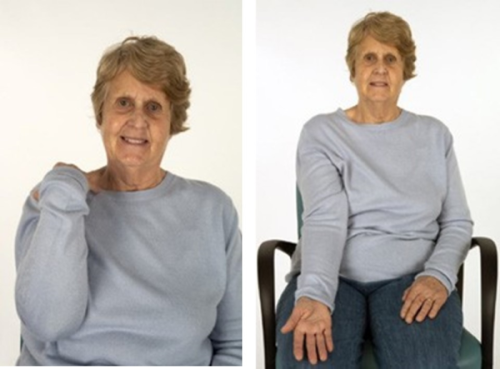
Using your arm
It will be some weeks before you feel comfortable to use your arm effectively.
Gradually increase the use of your arm as your confidence increases and the pain settles. Trying to use your arm to eat, drink, and care for yourself gives you the best chance of a successful recovery
Eating and drinking
You may need some help to eat and drink at first especially if you have injured your dominant arm.
- Eating ‘finger foods’ such as sandwiches can be easier than food that needs to be cut up using a knife and fork.
- There are adaptations such as a ‘plate guard’ (pictured below) or wide handled cutlery that can make it easier to eat. These items are widely available to purchase if required.
- Please ask a health professional if you are struggling and unsure what to do.

Walking aids
If you normally use a walking aid with your injured arm it is likely to be too painful to use this initially. You may need support from a physiotherapist or occupational therapist to explore alternatives to keep you mobile.
Once you are comfortable, you can use your arm normally to care for yourself– including putting weight through your arm to use walking aids if required.
3-6 weeks
Using your arm
You may find your arm is still very swollen down to your hand. This is normal and usually improves once you are using your arm more. If you remain worried please see the advice at the end of the leaflet.
If you’re not already using your arm much, now is a good time to start trying a bit more.
- Practicing with an empty cup will build your confidence for meal times if you struggle to begin with.
- Practice washing your face with your injured arm while sat at the sink. You can use the other hand to help if needed.
Removing your sling
You can start to gradually use the sling less over a few days if you feel ready. You may find it useful to continue to wear it if you are out and about in a busy environment, or standing for a long period of time.
Keep your hand supported when you are sitting and lying down to reduce swelling – try not to let it hang down by your side for extended periods of time.
Getting your shoulder moving
The following exercises are suggestions. The important thing is to gradually get your shoulder moving in whatever way you feel able to.
You might need help for the following exercises. Please speak to your community therapy team if they are involved in your care to help you with exercises.
Place your hand under the elbow of the injured arm. Lift gently until you feel a stretch at your shoulder. Start to gradually increase how far you can move your shoulder.

Place your hands on a table. Slide your hands along the table as far as you can without lifting your shoulders.
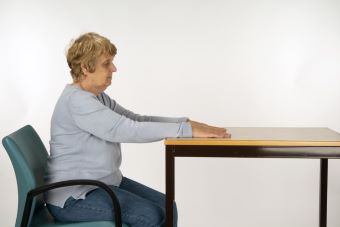
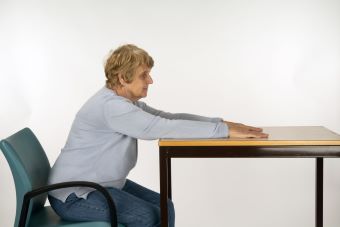
From 6 weeks
Continue with the previous exercises but start increasing how much you use your affected arm. You may only feel ready to do the exercises from week 3 at this point but keep trying to build up little and often.
If you are able to attend outpatient appointments and feel able to follow an exercise program, you might want to request an outpatient physiotherapy appointment at this stage. Your GP can send a referral or please contact the Frailty Trauma Practitioner for advice if required.
With these types of injuries it is not unusual to take 6-12 months for you to get your maximal usage back in your arm – aim for as much movement as possible but you may not get the same movement as you had before your injury.
When to seek further support or advice
If you find you need more practical support than anticipated when you get home then please contact Sirona who provide community based assessments through the Single Point of Access on 0300 125 6789
Injury concerns
- If you have worsening pain that doesn’t settle within 48 hours.
- If you notice any new change to the feeling in your hand or a new loss of movement in your hand or wrist at any stage after your injury.
- If you notice a new swelling.
If you are still significantly struggling with basic exercises or function after 6 weeks and have not been referred to outpatient physiotherapy, please contact the Frailty Trauma Practitioner to discuss referral. This is not an emergency service and calls may not be returned same day.
If you feel you need urgent medical advice please contact a relevant health care professional such as 111 or your GP.
Bone health and fracture prevention
Bones contain living tissue that is constantly being broken down and rebuilt. We call this process ‘bone turnover’.
As we get older, the process of making new bone is slower than the process of breaking down of old bone, and so the amount of bone tissue we have reduces,and bones can start to lose some of their strength and structure and become weaker. This may lead to a condition called osteoporosis.
A fracture that has happened easily after a minor injury such as a trip or fall is known as a fragility fracture. It is often the first sign that bones have lost some of their overall strength and structure.
People who have had a fragility fracture have a higher chance of having another fracture compared to someone who hasn’t had a fracture.
You may be contacted by the Fracture Liaison Service who will arrange to complete a ‘fracture risk assessment’ to see how likely you are to have further broken bones (fragility fractures). This may also be carried out by the team looking after you in hospital, or your own doctor at the GP surgery.
The fracture risk assessment can help to guide whether you should have some further tests or investigations for osteoporosis. If it indicates that you have a high chance (risk) of having fractures, it may be recommended that you start taking some medication to help slow down the bone turnover process and improve your bone strength. This will help reduce the chances of having significant fractures like a hip fracture or a compression fracture of one of the spinal bones.
What else can you do to keep your bones healthy?
A healthy lifestyle is important to reduce your risk of developing osteoporosis and having fractures, but if your risk for having fractures is high then it might not be enough on its own to reduce your chances of having further fractures.
Exercise is good for bone strength - even if you have osteoporosis, a combination of good balance, coordination, and reflexes can help to reduce your risk of having a slip, trip, or fall.
You may find it beneficial to do some strength and balance training to help reduce the chances of falls and further broken bones in the future.
You may have this offered as part of your care support after your injury. If not there are classes and groups in the community you may wish to join, such as the Staying Steady classes but if you have had one or more falls, or if you remain worried about falling, ask your GP to refer you to the specialist Falls Service.
You can also help your bones by not smoking and by not drinking too much alcohol. Smoking, and/or regularly drinking more than the recommended weekly amount of alcohol has a harmful effect on bones, reducing the body’s ability to absorb calcium and changing how bone-building cells work, and can slow down the healing of fractures.
Drinking more alcohol than the recommended safe amounts can also cause people to become unsteady on their feet and increase their chances of having falls and fractures.
You should also make sure you have enough calcium and vitamin D, either from a healthy balanced diet and safe exposure of your skin to sunlight during the spring and summer, or by taking calcium and/or vitamin D supplements.
For further information, you may wish to visit the website of the Royal Osteoporosis Society at www.theros.org.uk or contact their specialist nurse helpline on 0808 800 0035.
How to contact us:
Frailty Trauma Practitioner
07511 166031
Single Point of Access: Sirona community based assessments
0300 125 6789
Plaster room
0117 414 8606
0117 414 8607
Available: Monday - Friday 8:30am - 5pm Saturday, Sunday, and bank holidays 8:30am - 1pm
© North Bristol NHS Trust. This edition published May 2024. Review due May 2027. NBT002398.
